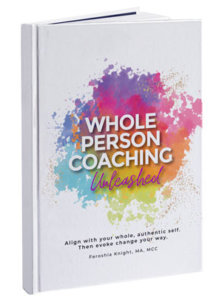Take a good look at yourself in the mirror. What do you see? What thoughts fill your mind? Do they make you feel good or do they send you into a spiral of self-doubt?
I’ll make this easy, and go first.
When I look in the mirror, I first see my energetic joyful self. My confidence strong; I fully embrace the wise woman beyond her years in the mirror.
Seconds later, a different version of me creeps in… that nasty self-critical voice of mine. Yes, even after all these years as a master coach, all those self-help books, workshops, seminars and therapy and coaching sessions under my belt, that voice still follows me around. Because of our frequent exchanges, I named this inner voice of mine Sally. It only seemed appropriate; the more I could relate to her, the more I’d be able to reason with her.
Here’s what she sounds like most of the time (usually screaming): “Your arms are flabby. You’ll never finish that book. You should go to the gym. Your so behind on everything!”
Her effect on me was profound and I couldn’t seem to shake her. After trying hypnosis, therapy, yoga, mindfulness meditation and a myriad of other techniques, I was desperate for a way to lose this bitch. All of those approaches worked for a bit, but then she’d be back looking for blood.
And that’s when I resolved to create a new relationship with Sally.
Listening to her, I’d begun to believe the crap she was telling me. Which caused me to develop some nasty habits. One of them was to isolate myself. She didn’t like what she saw in the mirror, so we stayed home. Another was to put my goals and dreams on the back burner. After all, if I wasn’t capable of achieving something worthwhile, why bother?
I began to worry that I’d become the old cat lady who’d die an unlived life, broken-hearted and alone. I saw the link between her words and the dead-end life I was living, and got curious. It was time to explore what was behind Sally and her diatribes.
I started listening to and writing down her words.
She always began her sentences with “YOU” followed by “SHOULD or SHOULDN’T.”
You should eat less.
You shouldn’t go to that party.
You shouldn’t __________________!
She was “shoulding” all over me. I grew frustrated, and wanted to eat more instead of less. Instead, I continued to listen and do my best not to react to her words.
I then noticed a pattern I now call “Conditional Statements.” I learned this term in a high school computer programming class. Sally’s language modeled the way in which people write software programs.
The pattern went like this:
If X happened then Y would follow, or else Z was surely to occur.
X = Was the situation/opportunity I was hesitant about
Y = Was one possible dreaded outcome
Z = Was the Worst Case Scenario I dreaded most
And, then her famous “shoulding” would follow thereafter.
Sally would express:
If you go to that party (X) then you’ll overeat (Y) and you’ll gain even more weight and you’ll never find a guy. (Z) You should stay home.
(And I would stay home, where I could control what I ate.)
This type of internal conversation happened anytime I wanted to do something that felt the tiniest bit uncomfortable. Like the time I tried to sing Barry Manilow’s “I Write the Songs” in front of my junior high assembly or the time when I was attracted to Billy, the smokin’ hot geeky guy in biochemistry but couldn’t get up the nerve to say hello. And I’ll never forget the day I decided to quit my minimum wage, day-job and start my own business. One would think I was about to lose my life by the tone of her voice and the language she’d use.
Probably the most important pattern I discovered was the one that shamed me into believing I was the problem. She’s often say to me: If you don’t do “X” then you’ll be a “Y.”
Here’s one of my favorites:
Sally would say: “If you don’t finish that book, you’ll be an impostor. After all, you’ve talked about it for over a year. Everyone will know you’re a loser.”
Sally is always ready with the low blows. Sure, I felt like a loser because I missed my own deadline, and yes I was excited and told everyone I’d be done, but for many reasons I was off deadline, and I was not a loser.
The Way Out
So I listened deeply and tried to hear what Sally meant by all those shoulds. I quickly began to see the positive intent behind what she said. She wanted to protect me. Her level of urgency and negativity was directly related to her fears around me falling into harm’s way.
More importantly, everything she spoke of was rooted in the past, and her seemingly rational way of viewing things was rarely relevant to what was happening in the present.
At all times, she operated as if the PAST was going to REPEAT itself, without regard to the fact that I was in a different time, with different people. And she never gave me credit that I’d grown wiser over the years.
That’s when I realized Sally was that part of me designed to keep me safe, sound, and alive in the world. She was that really young part of me locked in a time that had long passed by. She wasn’t living in the present, and because of her, I wasn’t living fully in my life.
And that’s when I drew a line, a boundary between Sally and myself. I chose to develop a different way of responding to her worries. Here is what I did:
I got curious. “What does Sally really need? She seems to react to things even before they happen.”
So I asked her. She told me she wanted to feel safe. She didn’t want to feel any uncomfortable feelings. She reminded me of the time the kids on the school playground grabbed my cheeks and told me I had a pudgy face. And the time I didn’t make it onto the cheer leading team because I was too fat. She’d repeatedly remind me about how that smokin’ hot guy, Billy, ended up in a relationship with another girl.
I gave her empathy & perspective. I empathized with her and then gently reminded her that there was more to those stories. Yes, those kids were cruel, but they were also jealous that I’d become the teacher’s pet. And the real reason I didn’t make the cheer-leading team was because I hadn’t rehearsed before try-outs. And, well Billy, I never got the courage to speak to him. He didn’t even know I existed.
I was able to convince Sally that those experiences didn’t happen quite the way she remembered them. And after a bit, she and I came to an agreement: that she could still speak up when she was afraid, but that she’d listen to me, too.
I proceed to fully live my life. I learned to face Sally’s fears and recognize them as the part of me that wants to play it safe. But more importantly, I developed a stronger sense of myself.
I invited out the parts of me that had disappeared because of Sally’s threats. Like the artist that loves to sing and dance, and the adventurer that loves to travel. Once I stepped into my whole self I felt more alive and awake to what my life had to offer. And Sally? She’s had new experiences to think and comment on.
Today when she shows up, she’ll still offer her wisdom, but I now know what to listen to and what to ignore. In fact, I sometimes turn our conversations into a game that she cannot win. It goes like this:
Hi Sally! I can hear you. Is it time to go to yoga? What do you really need? And then I pull out my Non-Violent Communication (NVC) needs list and together we discover what the real problem is and I act to get that need met. Most of the time, she just wants to know she’s been heard.
If you’ve got a critical voice in your head that keeps you hidden and small, I invite you to make friends with it. Give it a name. Ask it questions. And see what you discover!



